
This summer, Barbara Millicent Roberts, better known as Barbie, gets a big live-action movie starring Margot Robbie and Ryan Gosling. In a year when a new Super Mario Bros adventure has left everything else in its wake at the box office and Tetris provided the unlikely source material for a corporate thriller, 2023 looks like the year of toys and games adaptations. Let’s take a look at some other movies, good and bad, that have found inspiration in playthings and family pastimes…
Chess
I decided to learn chess during lockdown. It was a daunting prospect; I’d heard the often-quoted statistic that there are more potential game combinations than there are atoms in the observable universe, and there were times when I felt like I was staring into the abyss trying to get my head around everything happening on the board.
Like millions of other novice players, I was inspired to take it up thanks to The Queen’s Gambit. Anya Taylor-Joy made chess look so young and stylish and the mini-series was credited with driving a huge global surge of interest in chess.

Chess traces its origins to an Indian game called Chaturanga dating as far back as 600 A.D, and gradually evolved into its modern form by the 16th century. Its popularity increased further in the 19th and 20th century, reaching its peak of public interest in 1972 when Bobby Fischer defeated Boris Spassky to become World Champion and briefly broke a long period of dominance by Russian Grandmasters.
The enigmatic Fischer has been the subject of several films, both fictional and documentary, probably the best of which is Bobby Fischer Against the World. Otherwise, the venerable game doesn’t have many really good movies devoted to it. Most of them tend to be a bit worthy and staid. Its most iconic appearance in a feature film came in Ingmar Bergman’s The Seventh Seal, when Max von Sydow’s noble knight challenges Death to a game with his life as the prize.
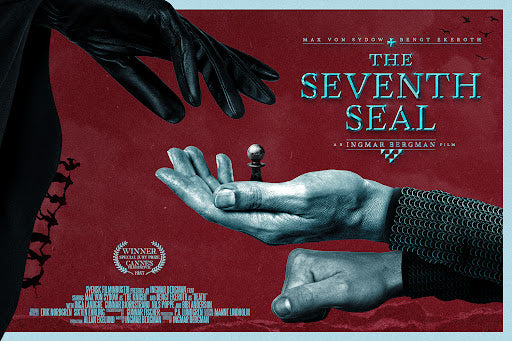
The scene was spoofed to great effect in Bill & Ted’s Bogus Journey. This time, Death (William Sadler) makes the mistake of letting the air-headed friends choose which games they play, and ends up getting resoundingly thrashed at Battleship, Twister, and Cluedo.
Cluedo
Taking inspiration from Agatha Christie and Raymond Chandler, musician Anthony Pratt devised Cluedo while hunkering down during air-raid blackouts in World War II. It wouldn’t go into production until 1949 due to supply shortages, but it became a massive hit; as of 2018, it was estimated that 150 million copies had been sold worldwide.
Pratt, however, missed his opportunity to become a millionaire off the back of his creation; unaware of its popularity across the pond, where it was simply known as Clue, he sold the rights in 1953 for £5000.
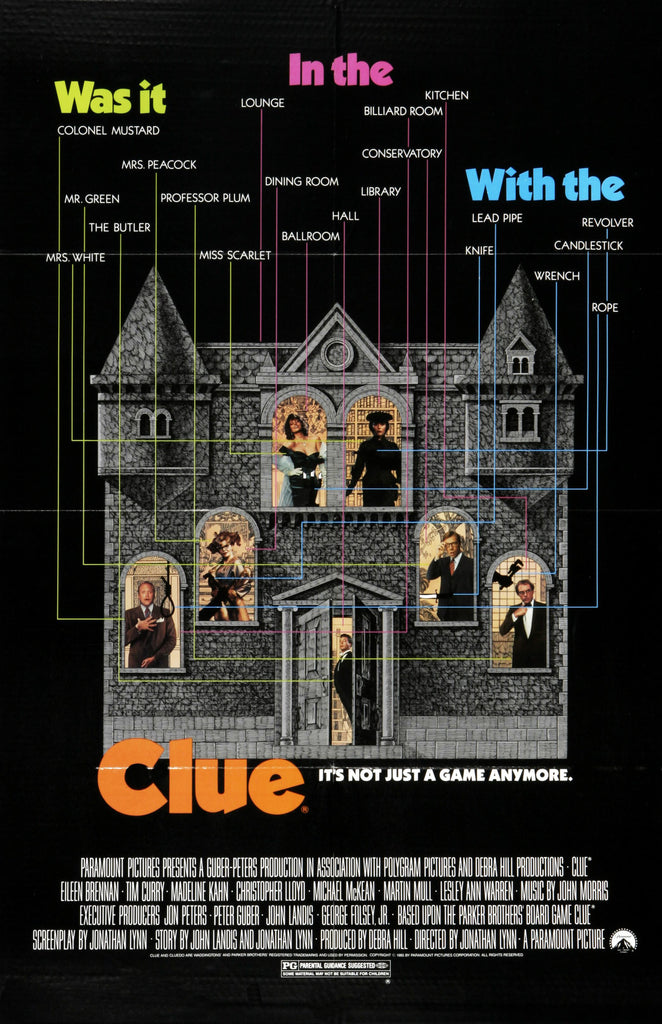
40 years later, director John Landis, backed by hot Hollywood producers Peter Guber (An American Werewolf in London, Flashdance) and Debra Hill (Halloween, Escape From New York), thought that Clue would be a marvellous idea for a motion picture.
Several writers were involved in the project at one point or another, including revered playwright Tom Stoppard and a dream-team of Stephen Sondheim (West Side Story) and Anthony Perkins, best known for playing Norman Bates in Psycho. None of them could crack the formula, and writing duties ended up with Jonathan Lynn, who had received widespread acclaim for Yes, Minister. When Landis jumped ship to direct Spies Like Us, Lynn also took over to helm the madcap farce.
The dry satirical wit of Yes, Minister was nowhere to be found in Clue, however. What we got was lots of broad slapstick, clunky wordplay, and boob and poop jokes. As a marketing gimmick, the film also rolled out to theatres with three alternate endings which would be played in different theatres.
Despite the game efforts of a talented cast including Tim Curry, Madeline Kahn, Christopher Lloyd, and the ever-wonderful Eileen Brennan, Clue was a box office flop and stabbed to death with a pen in the screening room by critics.
Since then, the film has built a devoted cult following, largely thanks to home video and steady rotation on cable and terrestrial TV channels. A remake starring Ryan Reynolds is in the works for the near future.
Battleship
Just the mere mention of Battleship instantly transports me back to rainy afternoons during school holidays, where boredom would get us breaking out the pens and paper to play the game with my Nan.
The origins of the game dates back to the early 20th Century, when it became popular with French and Russian soldiers in the trenches of World War I. Its widespread appeal led to a commercially printed version in 1931, followed by the classic Milton-Bradley plastic set with boards and pegs released in 1967. It was known by a few different names over the years, but Battleship is the one that stuck. Thanks to a series of TV adverts in the ‘70s and ‘80s, so did the phrase “You sank my Battleship!”
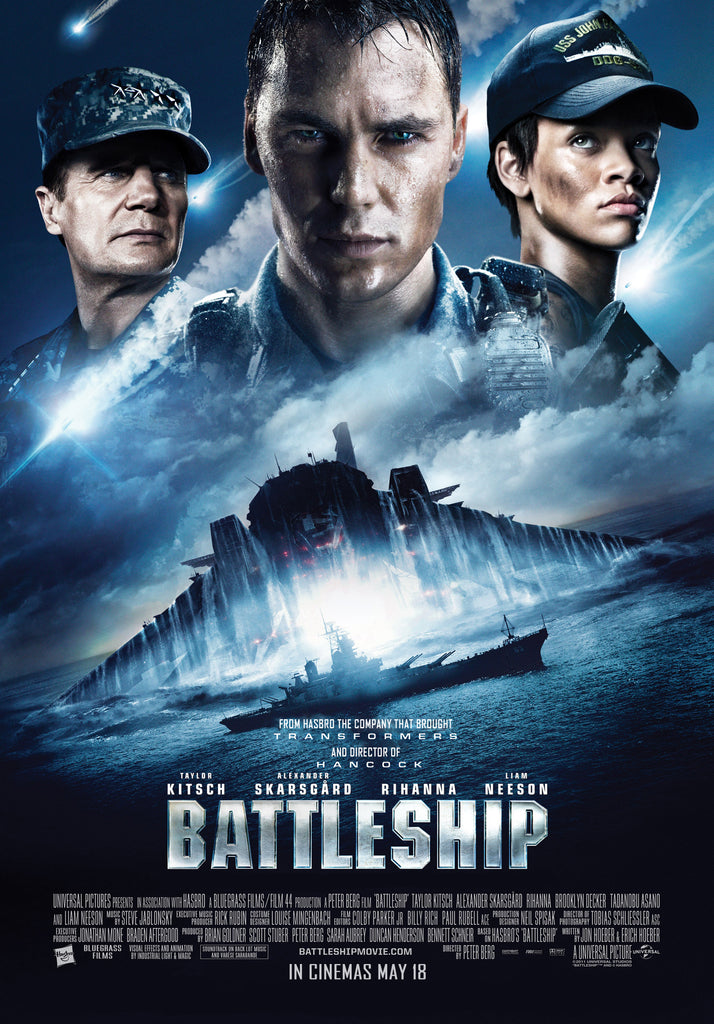
Despite the game’s enduring popularity, you might think that Battleship is pretty thin material for Hollywood blockbuster treatment. But that’s what we received in 2012 with Peter Berg’s gung-ho ode to U.S. naval might and can-do spirit starring Taylor Kitsch, swimsuit model Brooklyn Decker, Rihanna, and a slumming-it Liam Neeson.
With a budget of over $200 million, they couldn’t just make do with two fleets slugging it out, so we got a Navy battleship going toe-to-toe with evil aliens instead. It made money but was routinely panned by critics and received six Golden Raspberry nominations including Worst Picture and Director. Poor old Rihanna, making her theatrical debut, took home Worst Supporting Actress. To date, it is not confirmed whether Peter Berg will be following up with big-budget versions of Tic-Tac-Toe, Hangman, or Dots and Boxes.
Transformers
What could be cooler than robots that can change into cars, planes, guns, and… a cassette recorder? Not much, I decided when I was around seven years old, and Transformers usurped my Star Wars figures as my new must-have toys. The cherry on top was each robot’s rubsign, a little heat-sensitive sticker that revealed whether they were goodie Autobots or baddie Decepticons.
Transformers began life in 1980 as a Japanese toy range called Diaclone. Hasbro spotted the potential and snapped up the rights and designs, rebranding the series for western audiences in 1984.
Hasbro decided that the robots would be even more popular if they had proper backstories to go with the cool designs, and enlisted Marvel to develop the Transformers universe. It has grown very convoluted over the years, but the basic gist is a straightforward tale of good vs evil: Earth has become the battleground for the heroic Autobots, led by Optimus Prime, and villainous Decepticons, lorded over by the sinister Megatron.

This lore was fleshed out in the animated TV series which was followed by Transformers: The Movie in 1986. The film featured a wealth of vocal talent including Eric Idle, Leonard Nimmoy, Scatman Crothers, Judd Nelson, and, famously in his final role, Orson Welles. The movie was widely panned as too dark and cynical but it has a special place in the hearts of Transformers fans, especially due to the shocking death of Optimus Prime.
Many more animated adventures for the Autobots and Decepticons would follow, but they wouldn’t get a full live-action feature until 2007. Transformers sounded promising at first, backed by the clout of Steven Spielberg as Executive Producer. However, he made the fatal mistake of hiring Michael Bay to direct, who pumped up the over-reliance on military hardware and flashy CGI that rendered most bot battles incomprehensible blurs of clashing metal. As a result, the actual transforming part lost a lot of its magic.

The first film, starring Shia LeBoeuf and Megan Fox as the human protagonists, had its moments, but the subsequent movies became increasingly bloated and nonsensical, eventually pushing the three-hour mark. Despite mostly negative reviews, the franchise has become a box office powerhouse, racking up over $5 billion worldwide. To date, the sole bright spot has been the spinoff Bumblebee, which gave the series a much-needed infusion of heart and humour.
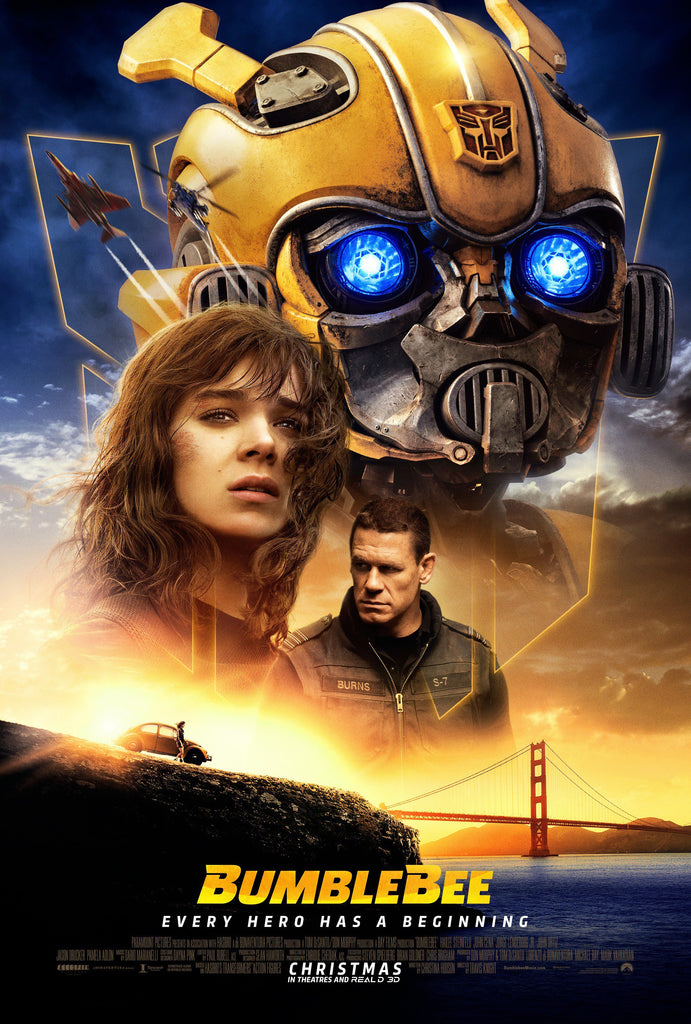
He-Man and the Masters of the Universe
There was a period in the ‘80s when school playgrounds echoed with the sound of squeaky-voiced little boys yelling “By the power of Grayskull!” and “I have the power!”
They were, of course, quoting the iconic moment in the He-Man and the Masters of the Universe when Prince Adam holds aloft his magic sword and turns into muscle-bound hero He-Man, and takes his faithful but cowardly pet Cringer along for the ride.
First broadcast in 1983, the hugely popular cartoon built on the existing lore of the He-Man range of toys that hit the shelves two years earlier. The action figures were devised by Mattel to compete with the booming success of Star Wars merchandise, and also drew from the sword-and-sorcery fantasy genre that was popular at the time.
The show took us to the fantasy world of Eternia and introduced many more popular characters including Cringer (who turned into his master’s fearless steed, Battle Cat), Man-at-Arms, Evil-Lyn, and Orko. They all became ingrained in ‘80s pop culture but the star of the show was Skeletor, given his maniacal cackle by voice-acting legend Alan Oppenheimer.
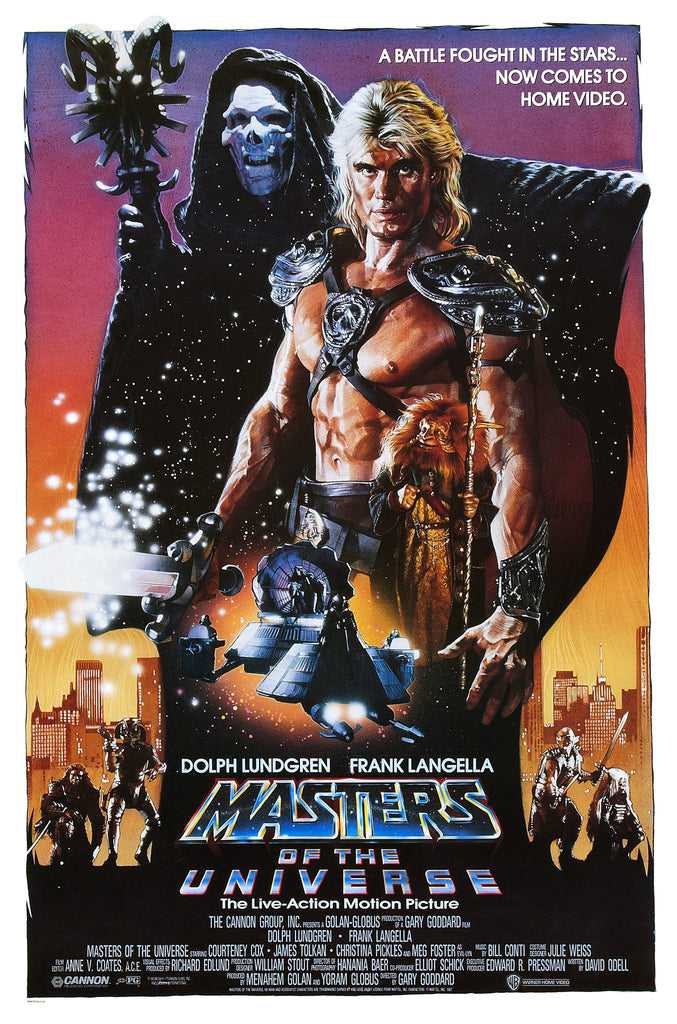
The show was a staple of many children’s TV schedules and a live-action film version inevitably followed, resulting in Masters of the Universe in 1987. Dolph Lundgren, who made such a forceful impression as Ivan Drago in Rocky IV, took on the role of He-Man sporting a blonde mullet, black underpants, and a leather S&M body harness. Frank Langella had fun playing Skeletor, prompted to take the part thanks to his young son’s love for the character.
The idea of the Masters of the Universe having a rumble on Earth sounds a lot more enjoyable than the movie actually is. The troubled production resulted in a dark and murky affair that looks a lot cheaper than its $22 million budget. We kids ate it up anyway, but then we also liked Krull, too.
He-Man and his buddies from Eternia enjoyed a resurgence in 2019 when two competing animated projects were announced. Arch-nerd Kevin Smith revealed he would be acting as producer and showrunner on Masters of the Universe: Revelation, which featured a great vocal cast including Mark Hamill as Skeletor. The show dropped on Netflix shortly before the more kid-friendly He-Man and the Masters of the Universe.
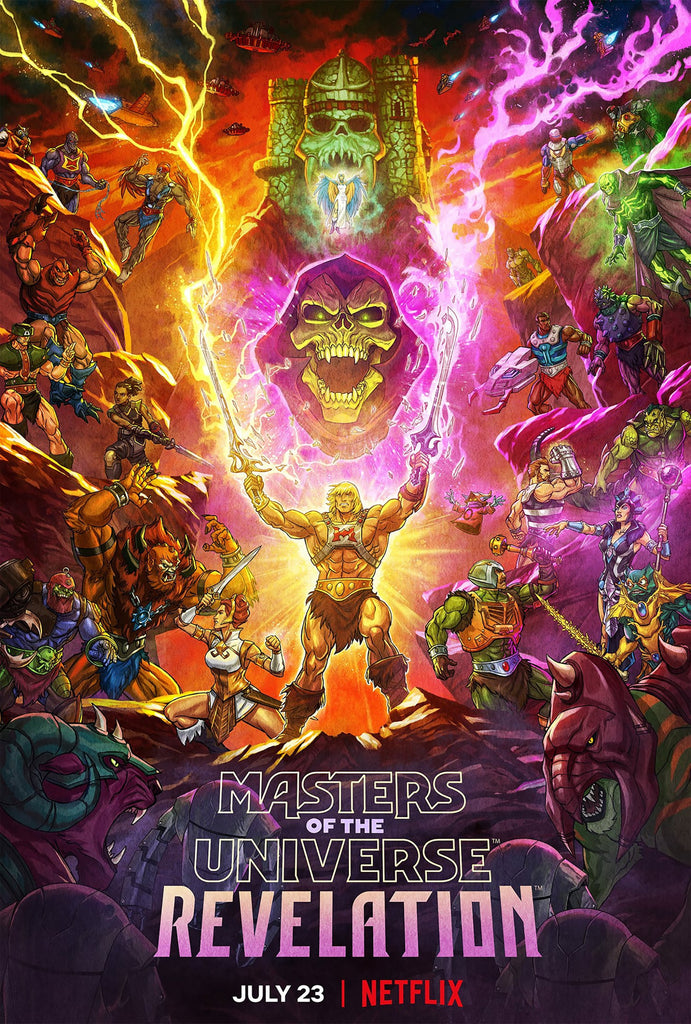
Dungeons & Dragons
For many people like myself who have never played Dungeons & Dragons, the game sounds ineffably nerdy, conjuring up images of socially awkward guys with neckbeards and Black Sabbath T-shirts huddled in a basement rolling strangely-shaped dice.
That’s the caricature, but there is also some truth behind it. Decades before geek culture became mainstream culture, D&D co-creator Gary Gygax summed up the core audience for his fantasy role-playing game:

Launched in 1974, Dungeons & Dragons went on to sell over 50 million copies worldwide, inspire the hugely successful range of Fighting Fantasy gamebooks, make Gygax a millionaire, and prompt moral panic in the ‘80s as religious groups blamed it for promoting witchcraft. It also spawned a franchise including books, comics, and TV series. So it was only a matter of time before someone tried to make a movie out of it.
The journey of D&D to its original big-screen outing in 2000 is a fraught Hollywood tale of warring factions slugging it out over rights and financing. Caught in the middle was D&D fan Courtney Solomon, who managed to wangle his way to the role of producer. The hellish pre-production phase meant that potential big-name directors like James Cameron, Francis Ford Coppola, and Renny Harlin all entered the frame and left again, and the projected $100 million budget was whittled down to less than half.
By the time cameras eventually rolled, it was Solomon himself wielding the megaphone. He had enthusiastically drummed up financing for the movie but his lack of directorial experience clearly showed in the muddled and largely joyless final film, which still flopped at the box office despite its slashed budget.

Several other film versions followed which found more favour with fans but made little impact with a wider audience, before this year’s Dungeons & Dragons: Honor Among Thieves arrived. Wisely, the film takes a more light-hearted Marvel-style approach to the IP, blending comedy and fantasy to appeal to casual viewers as well as fans of the game, corresponding with far better fortunes at the box office.

Garbage Pail Kids
After the Trolls (who would get their own musical comedy in 2016) came the Cabbage Patch Kids, another range of creepy dolls that girls inexplicably adored. Their success was followed by the Garbage Pail Kids trading cards, which gleefully lampooned their inspiration with a gallery of freaks in a variety of gross and/or violent poses. The anarchic nature of the series was typified by its most iconic character: Adam Bomb.
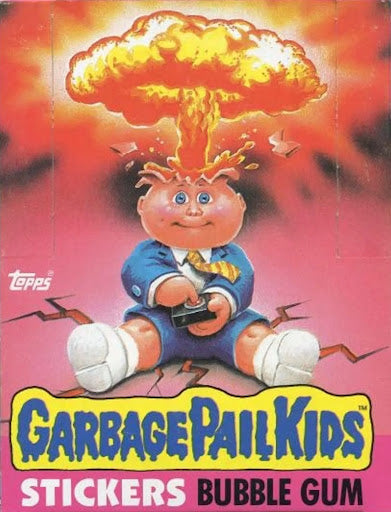
The card showed a chubby-cheeked schoolboy with a mushroom cloud exploding from the top of his head, neatly encapsulating the threat of nuclear annihilation in the final throes of the Cold War. That’s some pretty dark stuff, and of course the kids lapped it up. The Garbage Pail Kids quickly supplanted Panini football stickers as the swapsies of choice around my neck of the woods.
Garbage Pail Kids provoked controversy and school bans, which naturally added to their wild success. A live-action movie followed, featuring little people in creepy animatronic costumes, which is regarded as one of the worst films ever made.
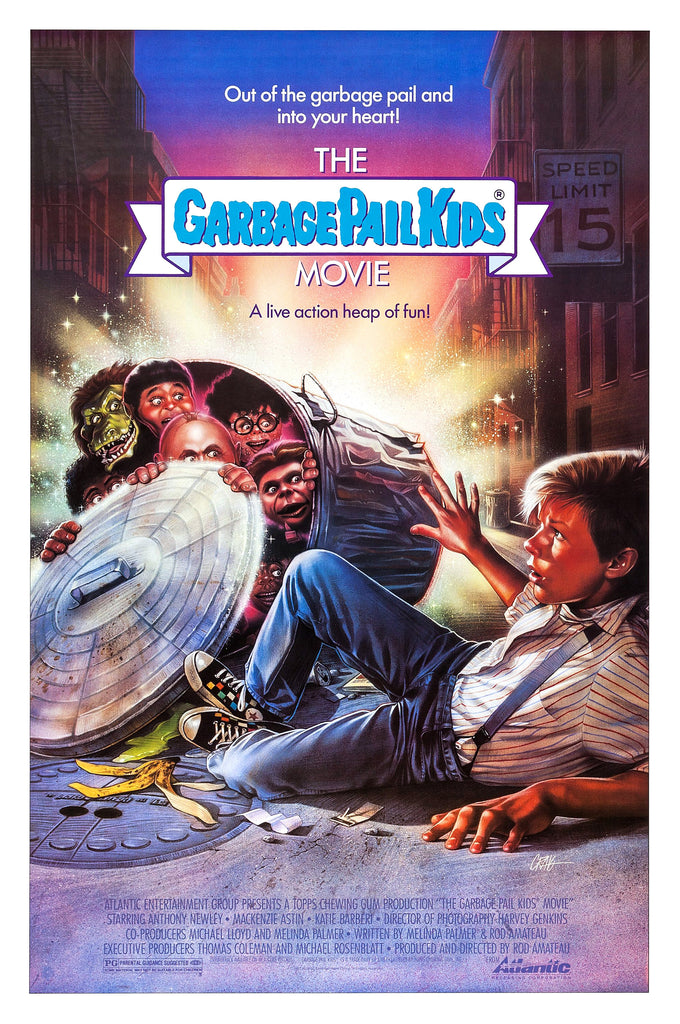
I don’t usually pay any attention to what Rotten Tomatoes says, but it must be pretty bad if it holds an approval rating of 0%. You can’t always rely on what critics say, but The Garbage Pail Kids Movie was universally reviled and earned a slew of Razzie nominations. The stench was so bad that a planned reboot in the 2000s was quickly canned due to negative reaction. All that kind of makes me want to watch it.
Ouija Boards
What shall we get little Johnny for Christmas? I know, how about an occult device to help him communicate with the spirit world? The history of automatic writing dates back as far as the Song dynasty in 1100 A.D., but at the turn of the 20th Century Ouija Boards were marketed as a parlour game. Indeed, you can still pick one up on Amazon with a wide range to choose from. The spooky nature of the item has lent itself to horror movies, making an important cameo appearance in The Exorcist. More recently, it became the focus of a new franchise in the jump-scare market with Ouija and its prequel, Ouija: Origin of Evil.
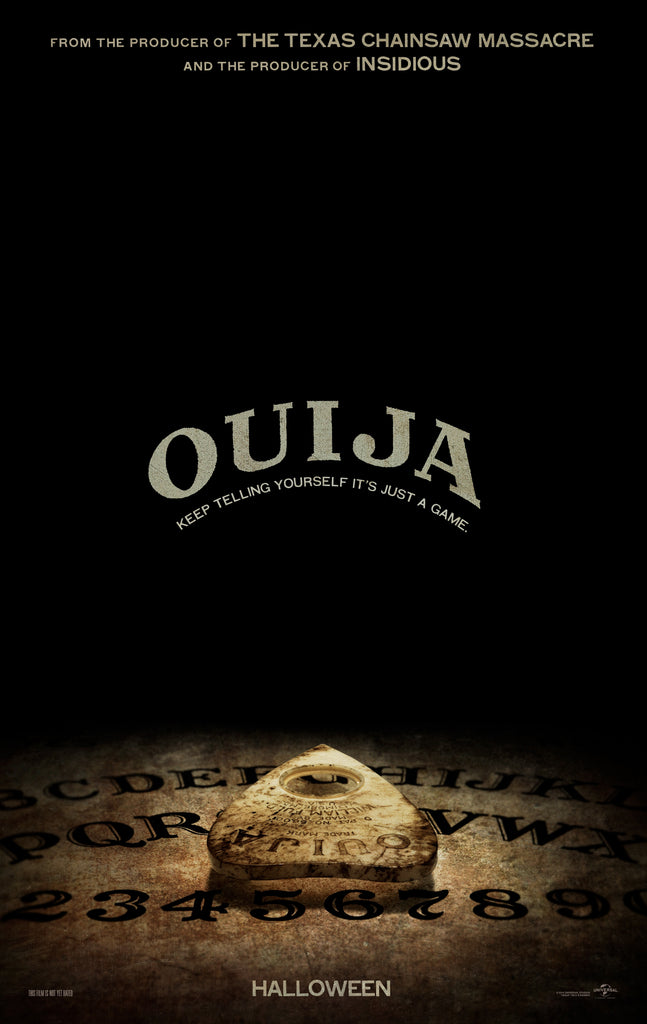
Lego
Derived from the Danish phrase “leg godt,” meaning “play well,” Lego began life as wooden building blocks crafted by Ole Kirk Christiansen in 1932. His company produced its first plastic brick in 1949, and popularity spread throughout Europe on its way to becoming one of the best-selling toys of all time.
The first Legoland theme park opened in Christiansen’s hometown of Billund, Denmark, in 1968, and chunkier bricks designed for younger children, Duplo, made their debut the following year. The biggest advance came several years later with the introduction of friendly-looking yellow humanoids called Minifigures, which would become a staple of the increasing range of Lego play sets.
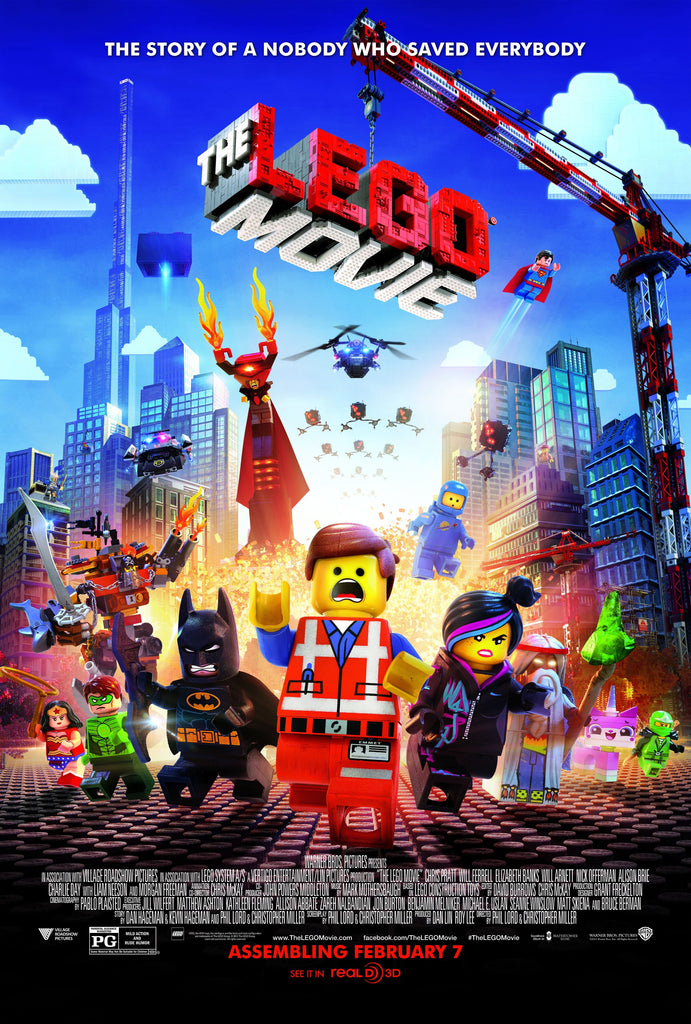
Lego was named “Toy of the Century” in 1998, but it must have seemed like an unlikely basis for a feature film at the time, although several direct-to-video movies aimed squarely at kids emerged in the 21st century.
Then came The Lego Movie in 2014. Honestly, who thought it would be any good? Yet the film was a surprise hit, universally loved by critics and becoming a box office smash. With a winning vocal cast including Chris Pratt, Morgan Freeman, Will Ferrell, a witty screenplay, and a stunningly realised Lego world, the film is arguably one of the best animated family movies of the 21st Century.
Criminally, it didn’t receive an Oscar nomination for Best Animated Feature but it became an instant classic. One of the reasons it works so well is how it celebrates the imagination kids use when playing with Lego, and matches that theme with some outrageously inventive ideas.

Three more Lego movies have followed so far, including a spinoff for the gruff and moody Lego Batman, voiced so wonderfully by Will Arnett.
Classic toys in Toy Story
Woody (Tom Hanks) and Buzz Lightyear (Tim Allen) instantly became iconic characters from the moment Toy Story hit theatres in 1995, and rightly so. However, much of the richness of the movie’s world comes from the array of classic toys who make up the supporting cast.

Chief among them is henpecked Mr. Potato Head, voiced so wonderfully by Don Rickles. The concept for the toy originally dates back to 1949, when New York artist George Lerner was looking for a novel way to get his kids to eat vegetables.
Other real-life toys in the movie range from lovable side-characters to small cameos. You also have a Slinky Dog, a Barrel of Monkeys, Etch-a-Sketch, a Speak and Spell machine, Troll Dolls, Rock ‘Em Sock ‘Em Robots, and many others over the course of the series. Barbie and Ken belatedly made an appearance in Toy Story 3, but perhaps the most beloved of the classic toys in the franchise are the Green Army Men.
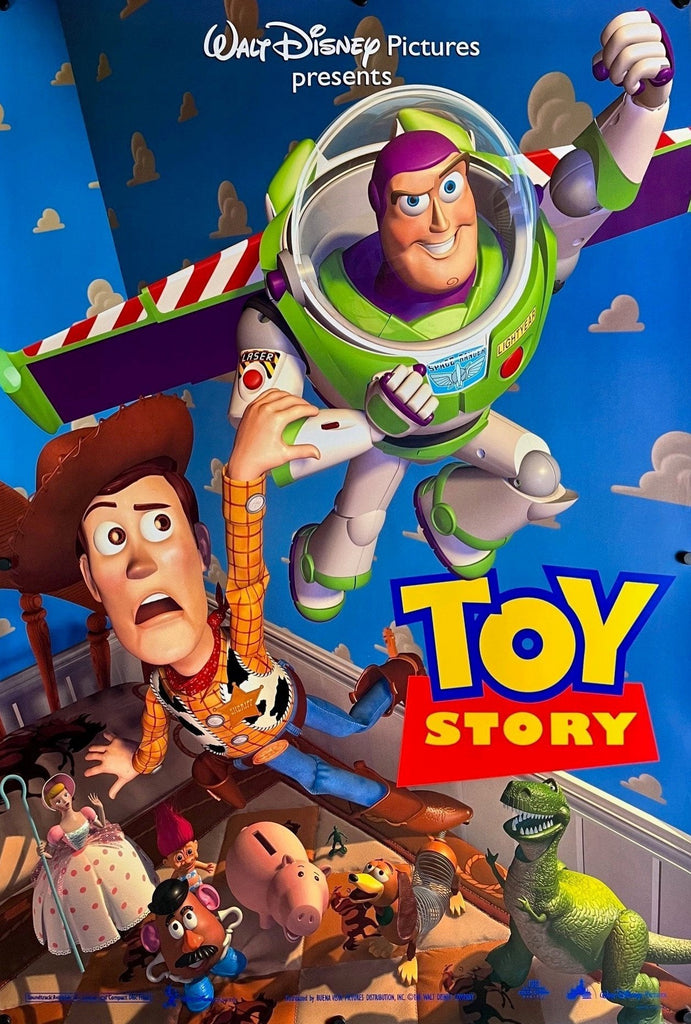
The cheaply made plastic figures, featuring US soldiers in a variety of poses, took over from traditional lead models in the 1930s. They are those kinds of toys that nobody placed at the top of their Christmas List but absolutely every kid had, and the recognition made everyone go wild when the soldiers embarked on their daring mission to report on Andy’s new gifts in the opening act of the film.
Super Mario Bros.
This year’s perfectly serviceable The Super Mario Bros. Movie has become a runaway hit, becoming the highest-grossing film based on a video game in the first week of its release as it butt-stomped its way to well over $1 billion worldwide. Significantly, it hit our screens 30 years after the first movie based on the adventures of Mario and Luigi, finally laying to rest the spectre of that strange misfire.
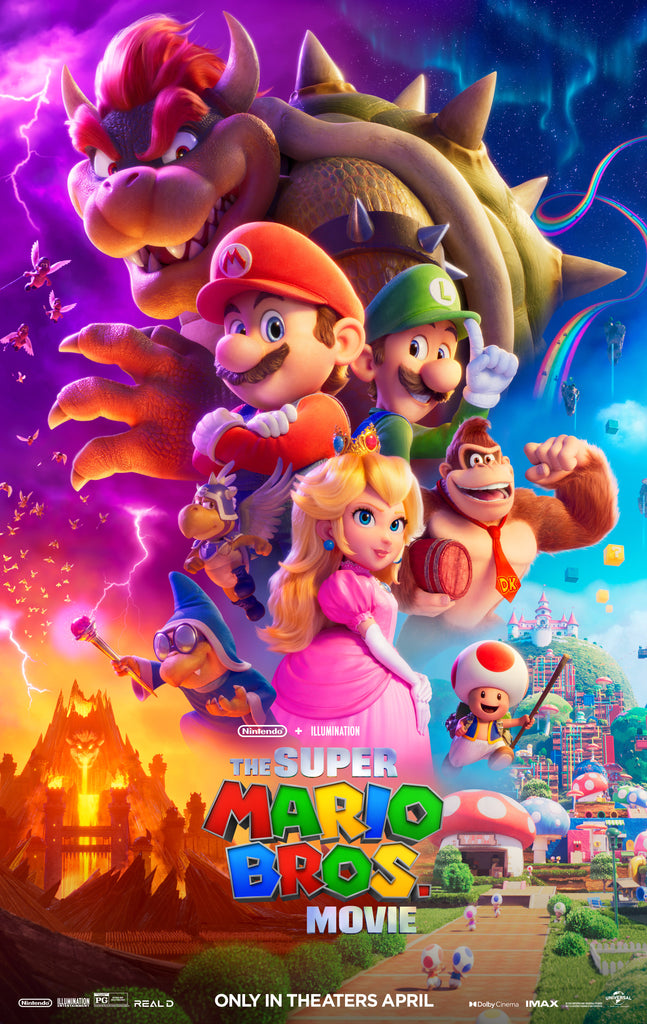
Mario, the plucky Italian plumber, made his first appearance in the arcade game Donkey Kong in 1981. Devised by Nintendo to rival Pac-Man, Mario had to scale a series of platforms, avoid objects hurled at him by the titular gorilla, and save the damsel in distress.
Donkey Kong was a hit, and Mario was later joined by his brother Luigi in the 1983 game Mario Bros., which introduced some of the mechanics that would become integral to the series. Then came the big one, Super Mario Bros., the 2D side-scroller developed initially for the NES (Nintendo Entertainment System). The game made Mario the mascot for Nintendo and it is no doubt one of the greatest video games ever made, as well as one of the best-selling. It still plays incredibly well now and kickstarted the popularity of the Mario Bros franchise which has spawned dozens of titles, including the racing classic Super Mario Kart.
The original idea for a movie based on Super Mario Bros came from an unlikely source: Roland Joffé, better known for Oscar-nominated prestige pictures like The Killing Fields and The Mission. To adapt the game, he enlisted the help of a screenwriter with similar credentials, Barry Morrow, also nominated for his Rain Man script. The working title of his Mario Bros. screenplay was “Drain Man.”
The producers felt that Morrow’s approach wasn’t right and several more writers were involved. Fatefully, it was felt the movie should take a darker approach like the recent successes of Batman and Teenage Mutant Ninja Turtles. That’s how we got the movie we got, with a good cast of Bob Hoskins, Dennis Hopper, and up-and-comers John Leguizamo and Samantha Mathis in a technically impressive dark adventure that sat weirdly at odds with the bright tone of its inspiration. The movie was a box office flop and Hoskins and Hopper later expressed deep regret about starring in the film, both describing it as a “nightmare” and a low-point in their careers.
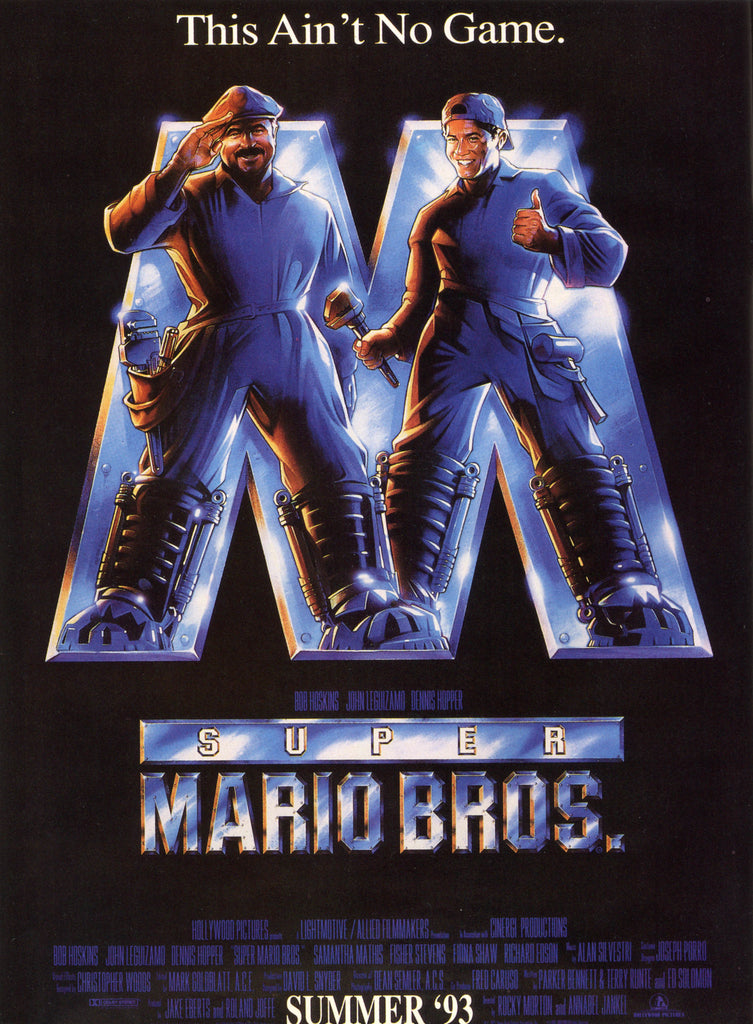
So there you have it, a selection of movies based on toys and video games. What are your favourites? Which is the worst? Let us know what you think!




